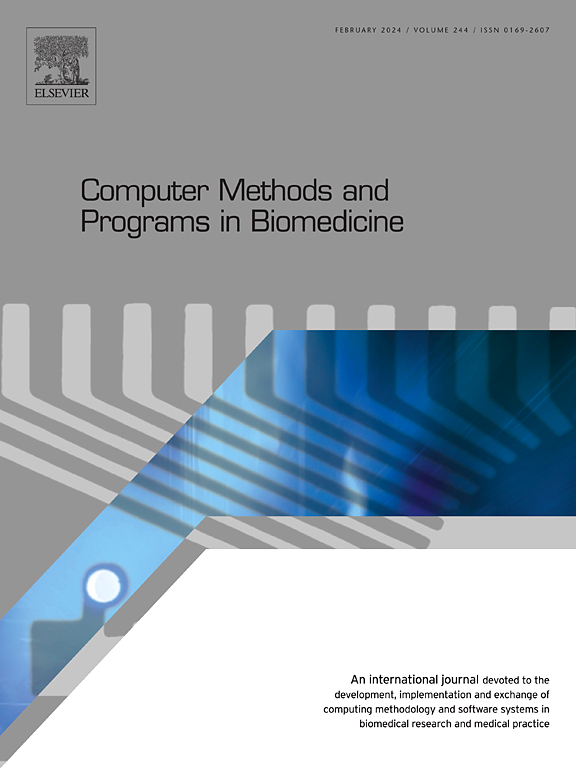三维心血管流非定常参数化最优控制问题的投影降阶建模
IF 4.9
2区 医学
Q1 COMPUTER SCIENCE, INTERDISCIPLINARY APPLICATIONS
引用次数: 0
摘要
背景与目的:由于复杂的血管形态、生理条件和高计算需求,在特定患者模型中准确定义流出边界条件具有重大挑战。这些挑战阻碍了通过结合临床数据(如4D磁共振成像)来计算真实可靠的心血管(CV)血流动力学。目的是控制流出边界条件,以优化CV血流动力学,并最大限度地减少目标和计算流速曲线之间的差异。针对非定常参数化最优控制问题(OCP(μ)s),提出了一种基于投影的降阶建模(ROM)框架。方法:OCP(μ)s的数值解需要大量的计算资源,这突出了对鲁棒和高效的rom进行实时和多查询模拟的需求。我们研究了一种基于投影的约简技术的性能,该技术依赖于离线-在线范式,能够显著节省计算成本。在本研究中,流体流动是由具有物理参数依赖性的非定常Navier-Stokes方程控制的,即雷诺数。采用伽辽金有限元法计算了脱机阶段的高保真解。我们实现了一种用于快速模拟OCP(μ)s的嵌套固有正交分解(nested-POD)方法,该方法包括两个阶段:时间压缩,用于在时间上降低维数,然后对预先计算的POD模式进行参数空间压缩。结果:我们测试了所提出的方法在血管模型上的有效性,即理想的分叉几何形状和患者特异性冠状动脉旁路移植术,在流出边界结合应力控制,并观察到与高保真策略相关的一致加速。我们观察了状态、伴随和控制方案之间的相互依赖关系,并给出了详细的流场特征,为动脉粥样硬化风险等因素提供了有价值的见解。结论:基于投影的ROM框架为模拟参数化CV流提供了一种高效、准确的方法。通过实现实时、患者特异性建模,这一进步支持个性化医疗干预,并改善血管区域疾病进展的预测。本文章由计算机程序翻译,如有差异,请以英文原文为准。
Projection-based reduced order modelling for unsteady parametrized optimal control problems in 3D cardiovascular flows
Background and Objective:
Accurately defining outflow boundary conditions in patient-specific models poses significant challenges due to complex vascular morphologies, physiological conditions, and high computational demands. These challenges hinder the computation of realistic and reliable cardiovascular (CV) haemodynamics by incorporating clinical data such as 4D magnetic resonance imaging. The objective is to control the outflow boundary conditions to optimize CV haemodynamics and minimize the discrepancy between target and computed flow velocity profiles. This paper presents a projection-based reduced order modelling (ROM) framework for unsteady parametrized optimal control problems (OCPs) arising from CV applications.
Methods:
Numerical solutions of OCPs require substantial computational resources, highlighting the need for robust and efficient ROMs to perform real-time and many-query simulations. We investigate the performance of a projection-based reduction technique that relies on the offline-online paradigm, enabling significant computational cost savings. In this study, the fluid flow is governed by unsteady Navier–Stokes equations with physical parametric dependence, i.e. the Reynolds number. The Galerkin finite element method is used to compute the high-fidelity solutions in the offline phase. We implemented a nested-proper orthogonal decomposition (nested-POD) for fast simulation of OCPs that encompasses two stages: temporal compression for reducing dimensionality in time, followed by parametric-space compression on the precomputed POD modes.
Results:
We tested the efficacy of the proposed methodology on vascular models, namely an idealized bifurcation geometry and a patient-specific coronary artery bypass graft, incorporating stress control at the outflow boundary and observing consistent speed-up with respect to high-fidelity strategies. We observed the inter-dependency between the state, adjoint, and control solutions and presented detailed flow field characteristics, providing valuable insights into factors such as atherosclerosis risk.
Conclusion:
The projection-based ROM framework provides an efficient and accurate approach for simulating parametrized CV flows. By enabling real-time, patient-specific modelling, this advancement supports personalized medical interventions and improves the predictions of disease progression in vascular regions.
求助全文
通过发布文献求助,成功后即可免费获取论文全文。
去求助
来源期刊

Computer methods and programs in biomedicine
工程技术-工程:生物医学
CiteScore
12.30
自引率
6.60%
发文量
601
审稿时长
135 days
期刊介绍:
To encourage the development of formal computing methods, and their application in biomedical research and medical practice, by illustration of fundamental principles in biomedical informatics research; to stimulate basic research into application software design; to report the state of research of biomedical information processing projects; to report new computer methodologies applied in biomedical areas; the eventual distribution of demonstrable software to avoid duplication of effort; to provide a forum for discussion and improvement of existing software; to optimize contact between national organizations and regional user groups by promoting an international exchange of information on formal methods, standards and software in biomedicine.
Computer Methods and Programs in Biomedicine covers computing methodology and software systems derived from computing science for implementation in all aspects of biomedical research and medical practice. It is designed to serve: biochemists; biologists; geneticists; immunologists; neuroscientists; pharmacologists; toxicologists; clinicians; epidemiologists; psychiatrists; psychologists; cardiologists; chemists; (radio)physicists; computer scientists; programmers and systems analysts; biomedical, clinical, electrical and other engineers; teachers of medical informatics and users of educational software.
 求助内容:
求助内容: 应助结果提醒方式:
应助结果提醒方式:


